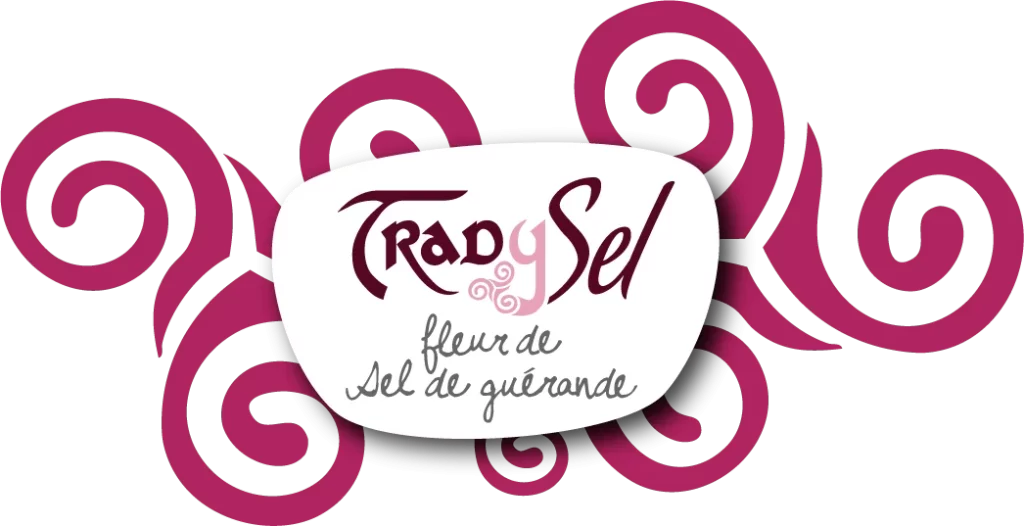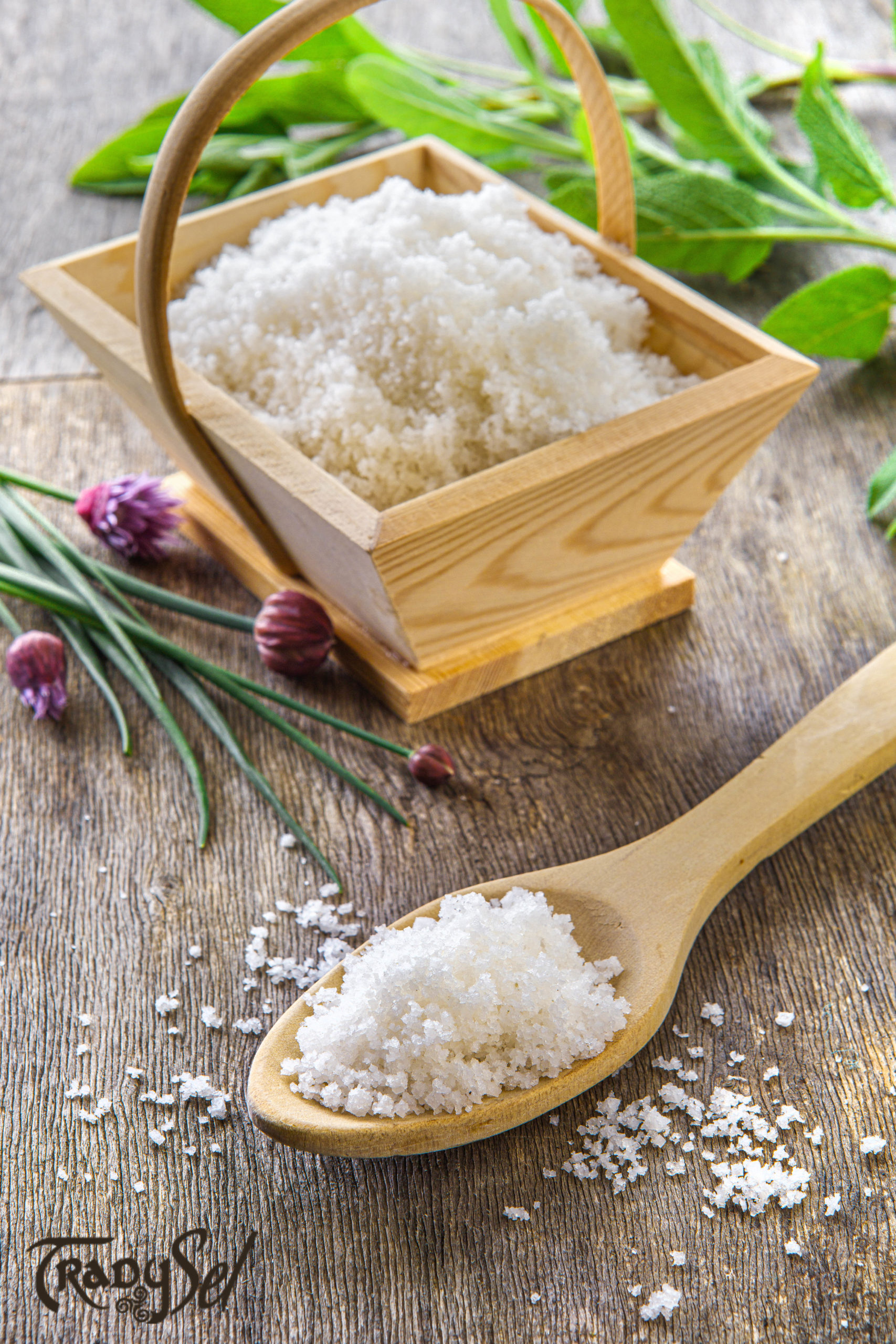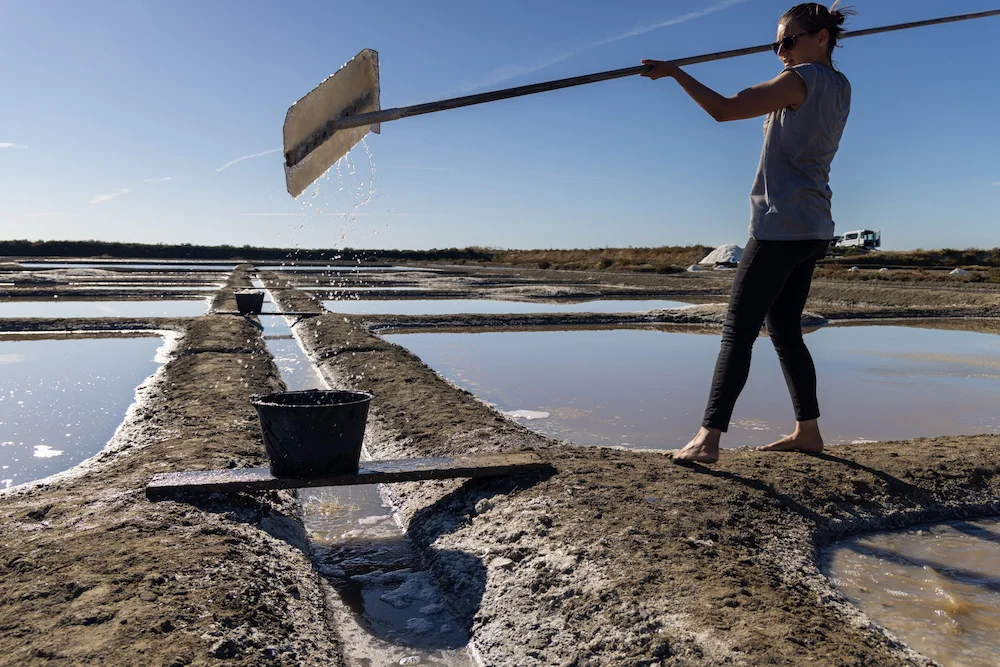Flower of salt TRADYSEL : 100% Guérande
The exceptional salt made in Brittany !
Our flower of salt is harvested with the same tools that have been used for centuries and we use no additives. It therefore has nothing to compare with refined industrial salts which are harder and more aggressive. TRAD Y SEL Guérande salt is natural and rich in minerals (magnesium, calcium, potassium, trace elements), its taste is fine, without bitterness or spiciness.
Due to its harvesting on a clay background, its crystals are grey, friable, wet and perfectly assimilable. The flower of salt must be picked every day on the surface of the water, this technique gives it a unique and subtle texture.
TRADYSEL salt only comes from the Guérande basin. The coarse gray salt is simply sifted, the ground salt is obtained after transformation of the coarse salt according to a gentle and qualitative method. The fleur de sel is neither dried nor sieved. Each product in the range is available in packaging suitable for both professionals and individuals. We also market large grains and agricultural salt in big bags for agriculture and animal feed.
The flower of salt
Melting and fragrant!


What is flower of salt ?
In the absence of legislation defining the product, we have a generic term:
“that which forms on the surface of a liquid” is the definition given in most dictionaries, as opposed to that which falls within the liquid or to the bottom.
In our case, flower of salt is crystallisation from a saturated saline solution, which occurs, like many changes in physical states, in the colder zones. For flower of salt, this happens on the surface where the air is colder than the sun-heated water, whereas for coarse salt, it is at the bottom where the clay is cool.
The crystals obtained are completely different: small inversed pyramids, crumbly and transient for flower of salt, and clumps of harder cubes, depending on the time they spend in the water, for coarse salt.
To enable production in the salt marshes, it is necessary to have shallow crystallisation ponds, of small size to avoid ripples, which if there is wind, would cause the flower of salt to sink.
If it does reach the bottom, it continues to crystallise, in a similar way to a coarse salt, in hard cubes, but in an organised way and not in clumps. It is a coarse salt crystallised around a flower of salt embryo. This product, however, does not correspond to the definition of flower of salt!
Whilst flower of salt cannot be produced by heating brine in an oven, after long periods of hot weather, when the clay bed is as hot as the water, our salt works produce a great deal, as the coarse salt no longer crystallises and the salt marshes are covered with flower of salt.
The true flower of salt is therefore unquestionably produced by a different crystallisation, and this is what imparts its quality and specific nature.
Why the term Flower of salt ?
Flower of salt comes from surface crystallisation, so why use the term “fleur” (flower) to talk about the surface? The reason is because it is found in the French words affleurer (to appear at the surface), effleurer (to lightly touch), à fleur de (on the surface of)…
The term is also found in “fleur de l’âge” (in the prime of life), defined by the Larousse dictionary as: “the freshness and spontaneity of one’s beginnings”. A real flower is transient and fragile, which gives its beauty.
It is an evident term for this rare product, which appears with the first gust of wind and disappears with the cool of the night.
True flower of salt must be harvested “à fleur d’eau” (skimmed from the surface), by hand, to avoid losing its specific characteristics.
The mechanically-harvested industrial products which invade the market do not merit the designation ‘flower of salt’. To mention only the biggest producers, “pseudo” flower of salt from the south of France, is harvested from grains which may have spent several months in the water. This is not an exception as most “flowers” from Spain and Portugal are produced in the same way.
Harvest
TRADYSEL Guérande flower of salt is made up of fine, light crystals which form and collect in wide layers on the surface of the crystallisation ponds (“oeillets”).
The salt is harvested every evening, during the hottest summer days, as the mother waters need to be heated to very high temperatures. The flower is gathered by delicately skimming the surface of the mother water
Tasting
TRAD Y SEL flower of salt does not undergo any processing between its harvesting and packaging. So the final product is the same as it was when the salt worker (“paludier”) harvested it.
TRAD Y SEL flower of salt has a melt in the mouth texture and delicate flavour. It should be used as a garnish to let its crystals melt on your tongue. It can accompany festive dishes, foie gras, shellfish, fresh or saltwater fish, meat, as well as even the simplest starters (raw vegetables, sauces) and home-made French fries.
The specificities
Rare product that sinks at the first gust of wind or disappears in the cool of the night.
Its name comes from the fact that it is indicated at the water’s edge. True fleur de sel must be indicated “fleur d’eau” by hand, otherwise it loses all its specific characteristics.
Like coarse salt, fleur de sel is stored for at least 12 months, then selected in Palox with systematic identification of the producer. It will then be conditioned, without being transformed. TRADYSEL fleur de sel is natural, guaranteed not to be dried, crushed or sieved.

The tool of the salt worker : The “lousse”
Traditional tool used to pick the flower from the surface of the water. It consists of a handle of about 3 meters and a flat perforated grid fixed obliquely.

